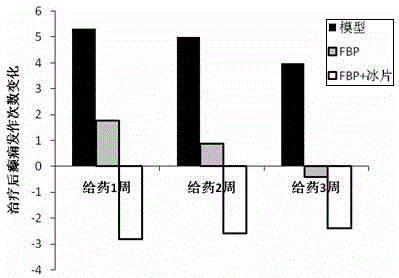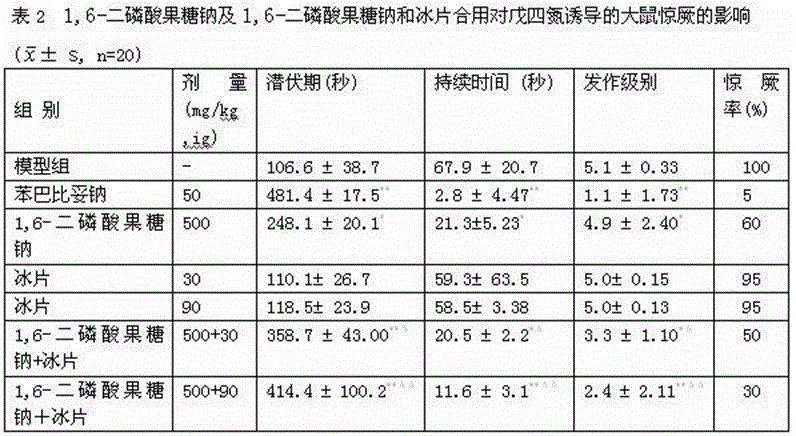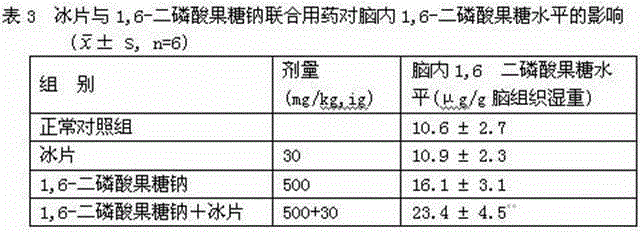Medicament application of 1, 6-fructose bisphosphate sodium salt containing borneol
A technology of sodium fructose diphosphate and borneol, applied in the application field of preparing antiepileptic drugs, can solve the problem of increasing the drug concentration of carbamazepine and sodium valproate in cerebrospinal fluid, no research report on the efficacy of epilepsy, and no research on borneol karma Effects of Xiping and Sodium Valproate on Antiepileptic Therapy and Other Issues
- Summary
- Abstract
- Description
- Claims
- Application Information
AI Technical Summary
Problems solved by technology
Method used
Image
Examples
Embodiment 1
[0012] Embodiment 1. Borneol enhances the effect of sodium fructose 1,6-diphosphate against penicillin-induced epileptic seizures in mice
[0013] The acute epilepsy model in mice induced by intraperitoneal injection of penicillin is a commonly used epilepsy model for studying the antiepileptic effect of drugs. By observing the latency of seizures (convulsions) and the percentage of epilepsy, it is judged whether the tested drug has antiepileptic effect.
[0014] Take 160 male ICR mice weighing 18-22g, and randomly group them into groups (see Table 1), 20 in each group. The test used 1,6-diphosphate fructose sodium salt (the raw material purchased from Zhangjiagang Huatian Pharmaceutical Co., Ltd., the same below) and borneol (commercially available traditional Chinese medicine, the same below), each group was administered by gavage, and the model The animals in the group without drug were fed with the same volume of distilled water, and the animals in each group were intra...
Embodiment 2
[0018] Embodiment 2. Borneol enhances the effect of sodium fructose 1,6-diphosphate on pentetrazol convulsions in rats
[0019] Pentylenetetrazol is a gamma-aminobutyric acid (GABA) receptor blocker, which can enhance the depolarization process of excitatory synapses and induce acute epilepsy models. The acute epilepsy model induced by a one-time injection of a large dose of pentylenetetrazol is one of the most commonly used methods for studying the activity of antiepileptic drugs. The acute epilepsy model was induced by intraperitoneal injection of large doses of pentylenetetrazol in rats to observe the effects of drugs on the behavior, latency, duration and incidence of epileptic seizures in rats. 180-220g male SD rats were randomly divided into groups (Table 2). Pre-administration was administered continuously for 3 days, once a day. The model group was given normal saline. 120 minutes after the last administration, the animals in each group were intraperitoneally inj...
Embodiment 3
[0023] Example 3: Borneol significantly enhances the antiepileptic efficacy of 1,6-diphosphate fructose sodium salt
[0024] The pilocarpine-induced chronic spontaneous epilepsy model in rats is an internationally recognized model of temporal lobe epilepsy, which is widely used in the study of the efficacy and mechanism of antiepileptic drugs. The pilocarpine-induced chronic spontaneous epilepsy model of adult male SD rats was prepared by conventional methods. According to the Racine standard, the degree of epileptic seizures was judged: grade 1: vibrating whiskers and chewing; grade 2: rhythmic nodding; grade 3: clonus of one forelimb; grade 4: standing with clonus of both forelimbs; grade 5: grade 4 + falling Accompanied by convulsions all over the body. The epileptic seizures of the animals with chronic epilepsy were continuously observed, and the specific observation time was from week 1 to week 6, from 9:00 am to 7:00 pm every day (continuous 10 hours). According to t...
PUM
 Login to View More
Login to View More Abstract
Description
Claims
Application Information
 Login to View More
Login to View More - R&D
- Intellectual Property
- Life Sciences
- Materials
- Tech Scout
- Unparalleled Data Quality
- Higher Quality Content
- 60% Fewer Hallucinations
Browse by: Latest US Patents, China's latest patents, Technical Efficacy Thesaurus, Application Domain, Technology Topic, Popular Technical Reports.
© 2025 PatSnap. All rights reserved.Legal|Privacy policy|Modern Slavery Act Transparency Statement|Sitemap|About US| Contact US: help@patsnap.com



